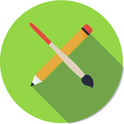#1 Creativity & Innovation | #2 Communication & Collaboration | #3 Research & Information Fluency |
#4 Critical Thinking, Problem Solving and Decision Making | #5 Digital Citizenship | #6 Technology Operations | Main Page
#4 Critical Thinking, Problem Solving and Decision Making | #5 Digital Citizenship | #6 Technology Operations | Main Page
|
Students demonstrate creative thinking, construct
knowledge, and develop innovative products and processes using technology.
|
ISTE describes creativity and innovation as a process in which “students demonstrate creative thinking, construct knowledge, and develop innovative products and processes using technology.” Technology does create some challenges but also many opportunities for fostering creativity and innovation in students. In order to construct knowledge, according to Dewey’s Pragmatic Theory, students must engage in a process of inquiry which leads to “new ways of seeing” the world. Such an inquiry is not terminated with a new finding but leads to new avenues of inquiry whose value is not judged by the outcome but whether it leads to new ways of seeing and inquiring. Technology, therefore, is not merely a tool in the process of inquiry, it is the relationship between a student’s question and the means of discovering possible answers. If technology is embedded in the inquiry process then it has no moral value as being good or bad for society but can be judged by its ability to further inquiry. In Microsoft’s vision for learning and living in the future, technology will become an integrated part of each person’s life. In the near future, technology will always be available to learn more about the world around us. For example, a heads up display will allow scuba diving scientists to quickly diagnose possible ailments afflicting underwater vegetation and 3-D printers will allow students to generate prototypes that solve real-world problems. Students will be able to synthesize their learning with others across the world using realistic videoconferencing tools and a large interactive display to create original works. Finally, in ubiquitous learning, learning occurs in increasingly socially-connected contexts, is problem-based and student-driven. Since there is also a blurring of informal and formal learning, students can begin to explore the problems they observe in the world around them and easily access information and experts to begin to develop innovative ways to address them from pollution levels in their town to learning about endangered species of birds.
|
Teacher Resources
Classroom ResourcesQuestion Formulation Technique |
A structured process for helping students develop and organize questions to encourage inquiry. Wevideo.com |
A platform that allows students to upload, create and edit videos to demonstrate their findings in creative formats. PowToon |
A platform that allows students to upload, create and edit animated videos to demonstrate their findings in creative formats. Blogger |
A blog that allows individuals or groups of students to share their learning using text and multimedia while commenting on each other’s work to further learning. ThingLink |
A platform that allows students to upload, create and edit interactive pages using hotspots to demonstrate their findings in creative formats. Biodigital Human |
A digital 3-D model of a human to understand the complex systems that support human life. Google Cardboard Expeditions |
A low-cost virtual reality system that allows students to explore settings all around the world from coral reefs to ancient ruins. Google Public Data |
Tools for compiling and visualizing various sets of data to draw conclusions and forecasts. Depicts data from international organizations like the World Trade Organization and International Monetary Fund. World Bank Data Visualizer |
Tools for compiling and visualizing various sets of data to draw conclusions and forecasts. Allows students to compare key social and economic indicators between all the countries of the world. Gap Minder Data Visualizer |
Tools for compiling and visualizing various sets of data to draw conclusions and forecasts. Graphs changes in key social and economic indicators across time. |
Blogs & Information ResourcesDesign Thinking |
A structured process for teaching students how to identify a problem, generate possible solutions and develop prototypes based on research. Teaching for Creativity |
(Blog Post by the Center for Development & Learning): A simple list of approaches to encourage students to think more creatively which range from how to reframe a problem to how to identify and surmount obstacles) Demystifying Creativity |
(Article by the Association of Supervision and Curriculum Development): This article explains how asking better questions, using project based learning, allowing students to explore & struggle, and letting students help design assessments can foster more creative thinking. Cultivating Creativity in a Standards-Based Classroom |
(Blog Post by Dr. Price-Mitchell for Edutopia) : Often times teachers feel that “covering” a significant number of learning standards in their curriculum makes it difficult for them to have students do more creative activities. In this article, Dr. Price-Mitchell provides 6 practical strategies ranging from practicing divergent thinking to helping students make connections) |

